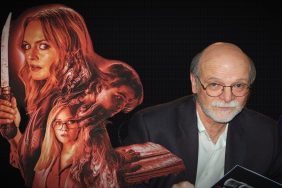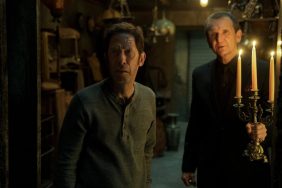
SHOCK takes a deeper look at 1962’s deranged semi-remake, THE CABINET OF CALIGARI.
Theres a song by Trent Reznors electro-outfit NINE INCH NAILS, the B-side to the single Sin; its a grinding cover version of the classic QUEEN song Get Down Make Love, that opens with one of the most memorable film samples in industrial music history.
It goes like this:
How old were you when you first let a man make love to you?
Next, who was he?
Next, how did you feel at the time?
Next, how did you feel afterward?
What did you feel, what did you think, were you pleased, frightened, ecstatic, disgusted?
What did he say, what words did you speak, that’s what I want to know, now, tell me, now, now, all of it, now, yes! Yes!
For years, no one I knew had a clue as to the origins of that sample.
I certainly hadnt the foggiest.
Eventually, I forgot about both the sample and the song.
That is until a few years ago, when I found a copy of the 1962 film THE CABINET OF CALIGARI in a discount bin at a used record store.
Thats right the 1962 film THE CABINET OF CALIGARI. Note the absence of the word Doctor.
I had no idea this film existed. Did you?
Taking it home excitedly and googling the shit out of it, I learned much of its origins and, while watching and grooving on it, I was floored when, in the middle, the films titular antagonist leans into his victim and barks that very same NIN sample.
So there it is. Mystery solved. But theres much, much more to THE CABINET OF CALIGARI than a simple pop music sound bite.
The film was directed by TV vet Roger Kay and produced by THE LAST MAN ON EARTHs Robert Lippert, an adaptation of an untitled Robert Bloch (author of the book on which PSYCHO was based) screenplay that was written in the wake of PSYCHOs success. Lippert had acquired the rights to the original, groundbreaking 1920 German expressionist silent film by Robert Wiene, THE CABINET OF DR. CALIGARI and, because of this, Lippert saddled that screenplay with the CALIGARI title, much to Blochs dismay.
The resulting film is not a remake of the Wiene film per se, rather it is its own, deeply strange beast, infused with elements of the original picture by director Kay, enough that it is most certainly a kind of companion picture. And while not a classic, it is most assuredly an interesting picture and offers many, many arch – and even gently obscene – pleasures. And, of course, that breathlessly crude sample
The film begins in true Freudian style (the movie absolutely owes more to Freud than it does to Wiene), with a POV shot of a moving car penetrating and then exiting a long, dark tunnel, an obvious allusion to sex. When daylight illuminates the frame, we see a beautiful woman (the elegant British actress Glynis Johns, only two years away from MARY POPPINS) driving; her lovely bare, shoeless legs rubbing against each other in a series of hazy, lush dissolves. Its a deliciously lurid, liquid opening that echoes PSYCHO in both texture and aesthetic; the first of many nods to Blochs most famous work
Johns plays Jane, a seemingly happy yet secretly, deeply neurotic, sexually repressed femme fatale who, after that aforementioned car winds up in a ditch, wanders in a daze to nearby house (shades again of Janet Leighs circumstantial arrival at The Bates Motel). The looming home an impossibly huge manor lorded over by the leering, educated and more than vaguely sinister Dr. Caligari (the great Dan OHerlihy, who is even more creepy here than he is in HALLOWEEN III) and his long-suffering personal assistant (Constance Ford, who was equally miserable and put-upon in the classic THE TWILIGHT ZONE episode Uncle Simon).

Jane agrees to stay the night at the house, a decision she soon regrets; come the dawn, shell realize that she and the other bizarre characters that inhabit the house are prisoners of the malevolent MD, both physically and psychically.
There really isnt much more to the plot of THE CABINET OF CALIGARI, rather the film serves as an ultra-sexualized exercise in pop-psychology and increasingly bizarre, hallucinatory exchanges of dialogue. The surrealism in CALIGARI is mainly milked from these word-wars, with Caligari battering Jane to the point of breaking, insisting on details about how she orgasms and other lurid intel (see again, that sample).

But the disorienting nature of the conversations and oddball character relations arent the only appealingly distorted elements of the film. Though it doesnt aspire to be a full-blown expressionist picture, it contains many ingredients that both tie it to the Wiene film (groove on that angled-stripe-doorway climax!), most tellingly in its kinky set design, with Caligaris office a staggering habitat that has a glass door that opens up into a revolving door and larger than life desk. Its not insane enough to channel any sort of cross-eyed, dream-logic grandeur but its ample weird enough to be memorable.
Also of note is the absolutely stunning, savagely widescreen 2:35:1 photography by PSYCHOs John L. Russell; almost the entire film is shot in long takes, with characters walking in and out of frame and rarely do you find more than two actors on screen at any time. That technique coupled with the dialogue-based nature of the film, gives the impression that you are indeed watching live theater, appropriate since the very birth of the German Expressionist movement and the original film stemmed from the stage.
Ultimately, THE CABINET OF CALIGARI is a strange and mesmerizing work but certainly not for all tastes. As a horror film, its not likely to please as the film is short on graphic death of any kind and actual suspense is minimal. But it does indeed harness some sort of strange power, like a post-modern smoothing out of the landmark original film, an impression of the expression, if you will.
And man its final scene is a real doozy.
Find it if you can and tell me your thoughts
And in the meantime get down. Make love.











